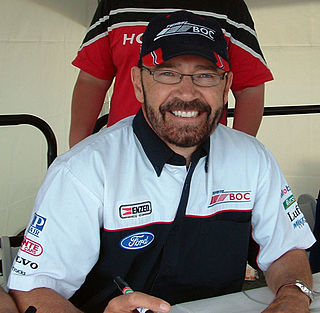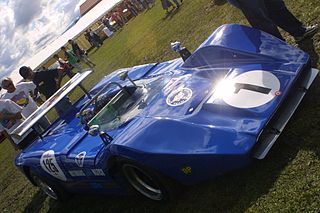Related Research Articles

Mallala Motor Sport Park is a 2.601 km (1.616 mi) bitumen motor racing circuit near the town of Mallala in South Australia, 55 km north of the state capital, Adelaide.

John Bowe is an Australian racing driver, presently racing a Holden Torana in the Touring Car Masters series.

Allan Maxwell Grice, known to motor-racing fans as "Gricey", is an Australian former racing driver and politician, most famous for twice winning the prestigious Bathurst 1000, and as a privateer driver of a Holden in the Australian Touring Car Championship.
The 1987 Australian Touring Car Championship was a motor racing competition which was open to Touring Cars complying with regulations as defined by the Confederation of Australian Motor Sport and based on FIA Group A rules. The championship, which was the 28th Australian Touring Car Championship, began on 1 March 1987 at Calder Park Raceway and ended on 5 July at Oran Park Raceway after nine rounds. The Calder round saw the world debut of the racing versions of the BMW M3, the Ford Sierra RS Cosworth and the Alfa Romeo 75 Turbo.

The 1984 Australian Grand Prix was a race for Formula Mondial racing cars, held at Calder Park Raceway in Victoria, Australia on 18 November 1984. It was contested over a distance of 160.9 km or an even 100 miles.
The 1980 Australian Grand Prix was a motor race held at Calder Park Raceway in Victoria, Australia on 16 November 1980.

Garrie Clifford Cooper was the founder of the highly successful Elfin Sports Cars and a competitive racing driver in his own right, winning the 1968 Singapore Grand Prix, the 1968 Australian 1½ Litre Championship, and the 1975 Australian Sports Car Championship - all in Elfin cars of his own design.

The 1984 Sandown 1000 was an endurance motor race staged at the Sandown Raceway in Victoria, Australia on 2 December 1984. It was the eleventh and final round of the 1984 FIA World Endurance Championship and was the first FIA World Championship race to be held in Australia. It was to be the first of a three-year contract to race at Sandown, though the final two years would be cancelled.
The 1989 Australian Drivers' Championship was an Australian motor racing competition open to racing cars complying with CAMS Formula Holden regulations. The championship winner was awarded the 1989 CAMS Gold Star as the Australian Drivers' Champion. It was the 33rd running of the Australian Drivers' Championship and the first to feature the Formula Holden class which had been developed during 1988, originally named Formula Australia.

Kaditcha was an automobile manufacturer in Australia. The company, formed by Queensland engineer Barry Lock, made open wheel and sports car racing cars, including cars for Formula 5000, Formula Pacific and Australian Formula 2.

The 1983 Australian Touring Car Championship was a CAMS sanctioned motor racing title for drivers of Group C Touring Cars. The title, which was the 24th Australian Touring Car Championship, was contested over a series which began on 6 February 1983 at Calder Park Raceway and ended on 19 June at Lakeside International Raceway after eight rounds.
The 1983 Australian Sports Car Championship was a CAMS sanctioned motor racing title for drivers of Group A Sports Cars. It was the fifteenth Australian Sports Car Championship.

Group A Sports Cars is an Australian motor racing category that CAMS formulated for sports car racing in Australia. Introduced in 1964, it continues today under the name Group 2A Sports Cars.
The 1985 Australian Sports Car Championship was a CAMS sanctioned motor racing title for drivers of Group A Sports Cars. It was the 17th Australian Sports Car Championship and the first to be run concurrently with the Australian GT Championship.
The 1988 Australian Sports Car Championship was a CAMS sanctioned motor racing competition open to Group 2A Sports Cars, FISA C1 cars, FISA C2 cars and Sports Sedans. The title, which was the 20th Australian Sports Car Championship, was contested over a four round series and was won by Alan Nolan, driving a Nola Chevrolet.
The Romano WE84 is an Australian designed and built, mid-engined closed top racing car built to CAMS Group A Sports Car specifications. The car began its life as the Kaditcha K583 when it first appeared in the 1983 Australian Sports Car Championship and was built by the Queensland based Kaditcha owner and former McLaren engineer Barry Lock after he was approached by Brisbane accountant, property developer, timber mill owner and former speedway racer Bap Romano in 1981 with the idea of building a Le Mans type coupe. When the car first appeared in 1983, it was the first closed top Sports Car seen in Australia and looked like an FIA Group C Sports Car rather than the open cockpit Can-Am style cars of previous years. This led to the false belief that it was built to the Group C regulations
The 1982 Australian Sports Car Championship was a CAMS sanctioned Australian motor racing title open to Group A Sports Cars. It was the fourteenth Australian Sports Car Championship, and the first to be contested by Group A cars since 1975. The championship was won by Chris Clearihan of Canberra, driving a Kaditcha.
The 1986 Australian Sports Car Championship was a CAMS sanctioned Australian motor racing title for drivers of Group A Sports Cars. It was the 18th Australian Sports Car Championship.
The 1987 Australian Sports Car Championship was a CAMS sanctioned Australian national motor racing title open to Group A Sports Cars, Group D GT cars, FISA Group C1 cars and FISA Group C2 cars.

The Veskanda C1 is a one-off, Australian designed and built, mid-engined closed top racing car built in 1985 to CAMS Group A Sports Car specifications. Powered by a Chevrolet V8 engine, the car is generally regarded as the fastest sports car ever built in Australia and as of 2016 remains one of Australia's fastest race cars.
References
- 1 2 3 4 5 6 7 8 Conditions for Australian Titles, CAMS Manual of Motor Sport, 1984, pages 88-91
- ↑ Australian Titles, CAMS Manual of Motor Sport, 2006, page 14-6
- ↑ 1984 Australian Sports Car Championship R1 H2, www.youtube.com
- 1 2 3 4 5 6 7 8 9 10 11 12 Barry Catford, Australian Sports Car Championship, Australian Motor Racing Year, 1984/85, pages 232-243
- ↑ Barry Catford, Our Top Car of 1984 - Romano WE84 Cosworth, Australian Motor Racing Year, 1984/85, pages 18-20
- 1 2 3 4 5 6 7 8 Round points and championship positions for the top ten places have been taken from the 1984 Australian Sports Car Championship Points Score Table, Australian Motor Racing Year, 1984/85, page 233. Other round points and championship positions have been calculated by applying the Conditions for Australian Titles information in the CAMS Manual of Motor Sport 1984 to the results in Australian Motor Racing Year, 1984/85, pages 232-243
- 1 2 3 4 5 6 7 8 9 10 Program, Calder Park, 29 April 1984